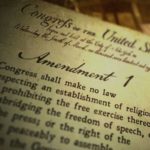This lesson plan is based on the Annenberg Classroom video “Freedom of the Press: New York Times v. U.S.,” which explores the First Amendment’s protection of a free press as well as the historic origins of this right and the ramifications of the landmark ruling in the Pentagon Papers case in which the Supreme Court ruled that prior restraint is unconstitutional.
Who Elects Our Senators
United States senators have been elected directly by voters since 1913. Prior to that time, state legislatures chose the state’s senators. In the mid-1850s, however, the state legislature selection process began to fail due to political infighting and corruption. Often Senate seats were left vacant for long periods of time while state legislatures debated who to send to the Senate.
Civic Friendship: ‘I Am Rooting Hard for You’
“You will be our President when you read this note. I wish you well. I wish your family well. Your success now is our country’s success. I am rooting hard for you.”
It doesn’t sound like a note that a politician would write to the man who had just defeated him in a hotly contested election for the highest office in the nation just a few months prior, yet these are the exact words penned by President George H.W. Bush to his successor, newly inaugurated President Bill Clinton, on January 20, 1993. Many of the tributes to the former president recounted the story of this note as evidence of the character of the man, of his grace and humility. In this eLesson, students will explore the importance of character traits like humility and respect in the individuals who hold public office and how commitment to the rule of law has sustained the executive branch throughout the country’s history.
Introducing the First Amendment
Students will inductively discover the First Amendment by reading and analyzing newspapers. They will discuss various circumstances involving the First Amendment, and so understand that in certain instances – libel, publication of national secrets, etc. – there is a limit to the freedoms expressed in the First Amendment.
Freedom of the Press: New York Times v. United States

This documentary examines the First Amendment’s protection of a free press as well as the historic origins of this right and the ramifications of the landmark ruling in New York Times v. United States in which the Supreme Court that prior restraint is unconstitutional. The federal government could not prevent newspapers from publishing the Pentagon Papers. A lesson plan, Defenders of Liberty: The People and the Press, accompanies the video.
The Constitutional Convention: To Sign or Not to Sign (Option A: The Historical Constitution)
NOTE: This lesson depends on a prior study of the Constitution Convention and the plan it produced, whether that study has been based on ConSource’s Constitutional Convention Simulation lessons or other curricula. Students will not be able to make a reasoned decision on whether to sign the Constitution unless they know what it is they are asked to endorse. Classes that have engaged in ConSource’s Constitutional Convention simulation can engage with both “To Sign or Not to Sign: Option A,” which asks students to cast a final vote on the Constitution of 1787, and “To Sign or Not to Sign: Option B,” which asks students to cast a final vote on the student-generated constitution.
Women Before the American Revolution
This short video explores the limited rights of women prior to the American Revolution. According to the idea of femme covert, women were legally and politically subservient to their husbands. Married women could not own property and all women were considered irrelevant to the political sphere. Professor Rosemarie Zagarri notes that 80% of the freemen in the colonies could vote (as compared to 20% in Great Britain), but suffrage was still limited to men.
Missouri v. Seibert (2004)
Does an officer’s questioning prior to the recitation of a Miranda warning undermine the protection offered by the Fifth Amendment? This case summary shows how the Supreme Court answered that question in 2004.
Slavery: No Freedom, No Rights (Lesson Plan)
Examine the history of slavery in the United States. Trace the development and expansion of slavery in the 19th century and learn about the conflicts and compromises that occurred prior to the Civil War and the abolition of slavery.
From the basics about slavery to the attitudes that defended it and the efforts of those who wanted to see it abolished, in this lesson students learn about this dark part of America’s past.
** Please note: The section about the Missouri Compromise and the Compromise of 1850 has been moved to a new mini-lesson called Slave States, Free States that explores the debate about the expansion of slavery. We recommend teaching this mini-lesson along with the Slavery lesson. Find it in our Geography Library.
Grade 9-12 The Bill of Rights 2.0
This lesson builds on prior knowledge of the United States Constitution and the Bill of Rights by asking students to think critically about the issues and philosophies central to both. Through investigation and debate, students are asked to question why certain rights were added to the Constitution and why others were not. The discussion will encourage students to synthesize historical and contemporary perspectives about their rights to decide if those rights are still relevant and comprehensive